Archive Page 42
April 29th, 2013 by dave dorsey
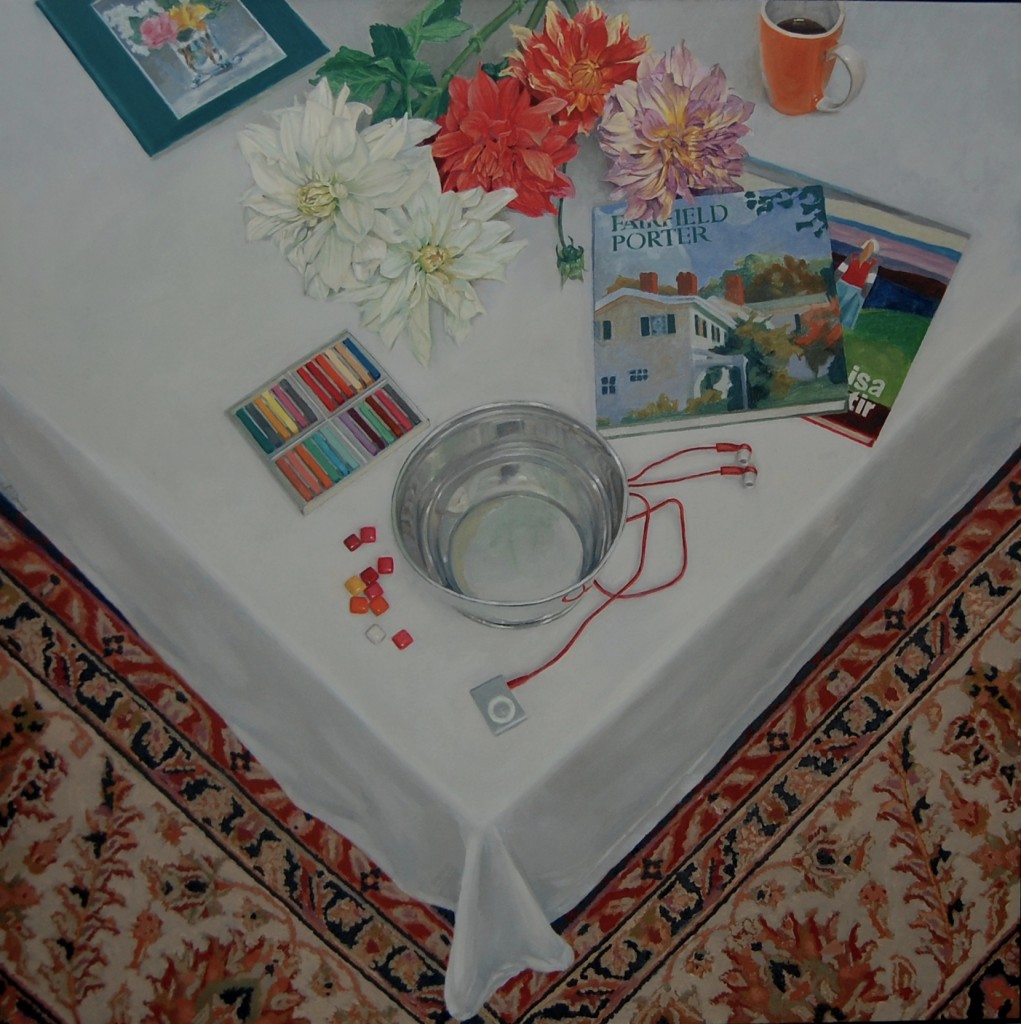
“Flowers from Another Year” has been accepted for Butler Institute of American Art’s 77th Midyear Exhibition, from Sunday June 30 through Sunday, August 18. This will be the first time I’ve shown work in the annual show.
April 29th, 2013 by dave dorsey

Andy Warhol
My wife is completely remodeling the bathroom upstairs, so for weeks we’ve had a steady traffic of foot-soldiers bearing drills, tile, dry wall, sinks, and all the other needed weaponry, up and down the stairs beside my studio, so I’ve been reading and doing other work, rather than painting. Which means I’m delving again into Donald Kuspit, circling around an idea of writing something in response to an excellent column about Warhol the New York Times published months ago. I came across this interesting footnote in The End of Art, about artists who crave a following:
David Aberback, Charisma in Politics, Religion and the Media: Private Trauma, Public Ideals (New York University Press, p. ix) He notes that the charismatic gains power over the public by craving to be loved by it and even belong to it, “though hurt and disillusioned in private life.” Thus, the charismatic becomes a kind of helpless baby and brings out the helpless baby in everyone. As Aberbach writes . . . the baby seeks “charismatic union” with a parent–the public at large in the case of an artist like Warhol, whose charismatic appeal was so great, that is, whose “craving for relation” (wish to belong and to be unconditionally and uncritically loved) was so intense, that it rubbed off on his possessions. One helps Warhol by believing that everything he touches is aesthetically significant.
April 29th, 2013 by dave dorsey
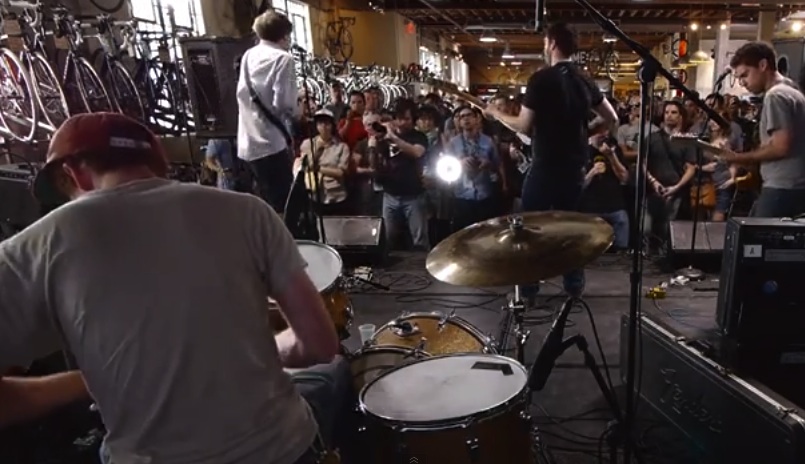
Parquet Courts play in Buffalo on June 26. Learning this an hour ago made my day. I can’t remember the last time I had a chance to hear a perfect set of music, as I expect it to be. I would have been willing to pay far more than $10 to get in. I think my favorite line from all of their songs so far is, “We all know what happened to Socrates.” They make me feel the way Nirvana made me feel when they emerged: there’s still hope.
April 21st, 2013 by dave dorsey
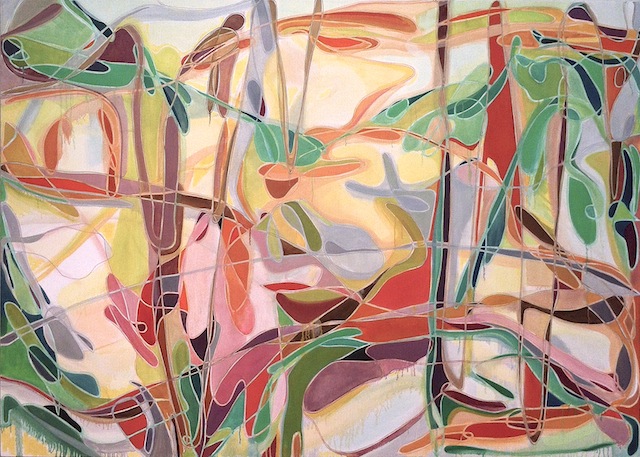
Jennifer Riley, “Wolfcreek Winter” (2013). Oil on canvas, 60 x 84 inches (All images courtesy the artist and Allegra LaViola Gallery)
“I might lean towards a pantheistic view of the world. The lessons of Color Field Painting and Abstract Expressionism, of not reporting on the visible but revealing the unknown, could also be brought into the discussion. I think, however, that wanting to depict/relate images of hard facts needs to be balanced by an awareness of what lies beyond the boundaries.” –Jennifer Riley, Hyperallergic
Her current show of paintings and drawings: Memory from Sight, at Allegra LaViola
April 18th, 2013 by dave dorsey
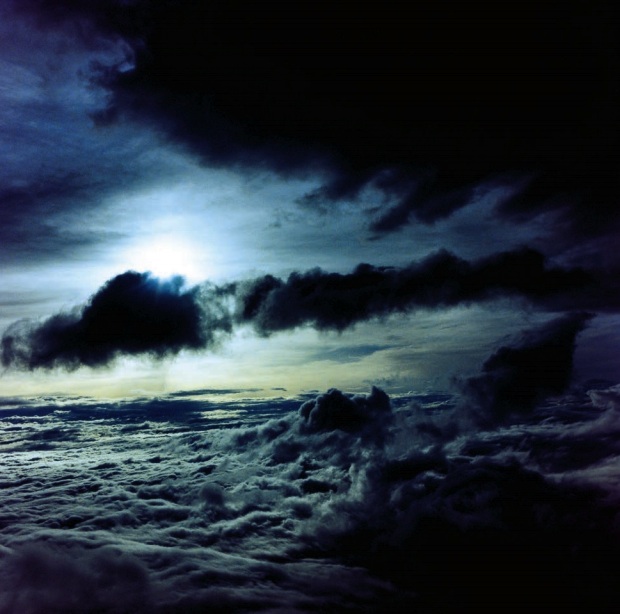
“Dawn 37”, Yu Tamauchi, from the current issue of Harper’s
Well I guess this puts me in my place (re: my previous post). This was taken from the summit of Mt. Fuji. Small detail: Yu Tamauchi lived near the top of that famous mountain in a hut for five months, taking photographs. At the risk of sounding way, way too much like Chris Farley interviewing Paul McCartney, let me just say . . . what an awesome idea. Two shots from this series appear in the current issue of Harper’s, and they were on view in December at Miyako Yoshinaga Gallery. I would wager a fairly unwieldy sum of money that Mr. Tamauchi was not using an iPhone. On the other hand, would it matter if he had?
April 17th, 2013 by dave dorsey
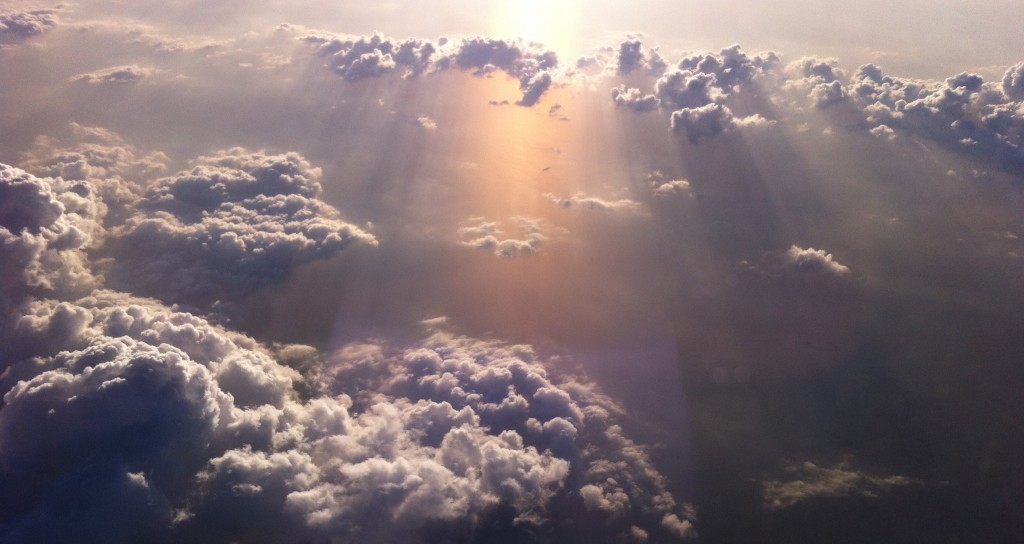
The more I use the iPhone to take photographs, the more I like it. It’s limited, like a Polaroid–that probably won’t last–but sometimes that makes what you get more interesting, also like a Polaroid. (I didn’t do anything to this one: no Instagram filter.) But what I like most is how it turns a camera into an appendage. I see; I shoot. There’s no planning. This was taken from my Southwest Airlines window and the sun was low, but not setting.
April 7th, 2013 by dave dorsey
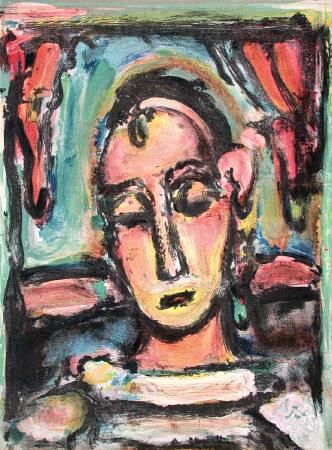
Pierrot, Georges Roualt
“Take up one idea. Make that one idea your life; dream of it; think of it; live on that idea. Let the brain, the body, muscles, nerves, every part of your body be full of that idea, and just leave every other idea alone.” –Vivekananda
April 6th, 2013 by dave dorsey
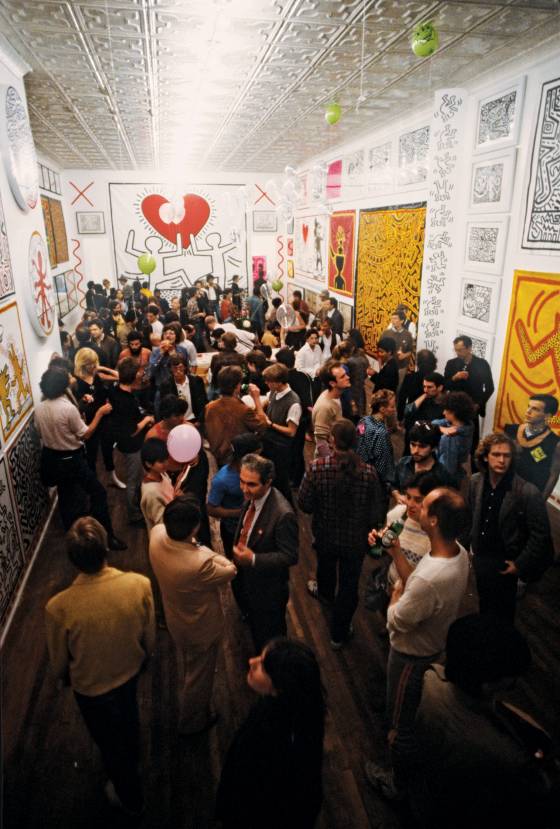
Artists and dealers are as passionate as ever about creating good shows, but fewer and fewer people are actually seeing them. Chelsea galleries used to hum with activity; now they’re often eerily empty. Sometimes I’m nearly alone. Even on some weekends, galleries are quiet, and that’s never been true in my 30 years here. (There are exceptions, such as Gagosian’s current blockbuster Basquiat survey.) Fewer ideas are being exchanged, fewer aesthetic arguments initiated. I can’t turn to the woman next to me and ask what she thinks, because there’s nobody there.
Instead, the blood sport of taste is playing out in circles of hedge-fund billionaires and professional curators, many of whom claim to be anti-market. There used to be shared story lines of contemporary art: the way artists developed, exchanged ideas, caromed off each other’s work, engaged with their critics. Now no one knows the narrative; the thread has been lost. Shows go up but don’t seem to have consequences, other than sales or no sales. Nothing builds off much else. Art can’t get traction. A jadedness appears in people who aren’t jaded. Artists enjoying global-market success avoid showing in New York for fear any critical response will interfere with sales. (As if iffy international art stars could have their juggernauts stalled by a measly bad review or two. A critic can only dream.) Ask any artist: They’re all starting to wonder what’s going on. —Jerry Saltz
A great piece from Mr. Saltz at New York magazine, though I think he’s partly transposing onto current events the lack of a feeling he would have gotten decades ago when people thought art was historically progressive and something novel was afoot. What he’s saying is all true, at least from the view I get through my tiny, inefficient portal into the economic wasteland as it looks from out here in the hinterland. In terms of how money gets spent, obviously, something is replacing the gallery show but it isn’t friendly and it’s more about investment than any sort of passion for what art can do. “The whole middle is being pulverized.” In other words, the art world follows the money and the money is all in the hands of people who just want to protect and increase it. On the other hand, maybe this is the sort of collapse that happens before something new and vital and more democratic emerges? As in France and America a couple hundred years ago (Not that anybody has a good idea how to replace an entire system that’s driving this country through yet another bubble toward another precipice.) Meanwhile, people talk about how to control assault weapons and whatever nutty thing Korea is doing to distract us from the fact that everything has ground to a halt. Depressing and sad.
April 4th, 2013 by dave dorsey
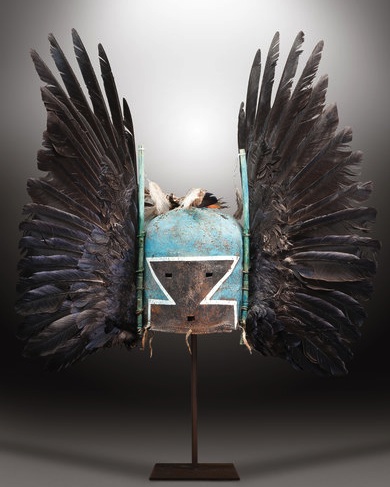
Hopi mask at auction in Paris
Can I please be the Hopi shaman who got to wear this helmet? Ah. OK. I didn’t think so.
On April 12 the Néret-Minet auction house in Paris will auction many sacred Hopi artifacts, over the objections of the tribe. Above, a helmet representing the Crow Mother, made from leather recycled from a Mexican saddle and feathers, is among the artifacts up for auction. Others are shown in this NYTimes slide show.
“The Hopis, who number about 18,000 in northeast Arizona, believe the objects in the Paris sale, which they call Katsinam, or ‘friends,’ are imbued with divine spirits. The brightly colored visages and headdresses, often adorned with horsehair, sheepskin, feathers and maize, are thought to embody the spirits of warriors, animals, messengers, fire, rain and clouds, among other things.”
Embodying the spirits of fire, rain, and clouds sounds like my idea of art, actually. Sacred or not, most of these look as if they were created right now. Paul Klee would have loved them. And Picasso.
April 2nd, 2013 by dave dorsey
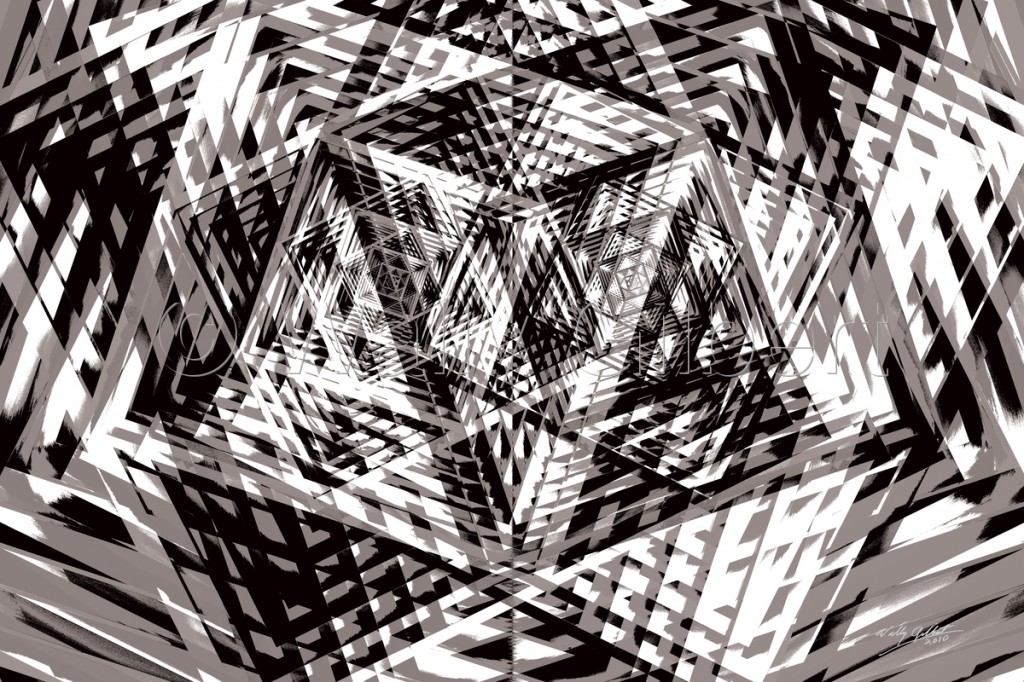
Displaced #2, Wally Gilbert
Back in 1987, here’s how the New York Times described the work that won Wally Gilbert the Nobel Prize:
In the mid-1970’s, Walter Gilbert developed with Allan Maxam (then a lab technician) a technique that, by chemically cutting DNA into segments of varying lengths, vastly simplified the reading of DNA messages. This rapid-sequencing method, together with a similar one developed by the British scientist Frederick Sanger, increased by a thousandfold the rate at which DNA information could be read, accelerating the pace of genetics research – and also earning both Gilbert and Sanger the Nobel Prize in Chemistry in 1980.
In 1986, at a conference sponsored by the Los Alamos National Laboratory, Gilbert inspired scientists to undertake the quest his work had helped make possible: to decode the human genome. Now, a quarter century later, that work has been done and science is able to look DNA as a laboratory, not just a code that governs biological reproduction and evolution.
As Gilbert told me recently, “We discovered very rapid ways of deciphering (the genetic code) and the world began to sequence DNA and genes. Twenty-five years later the first human genome was sequenced–three billion bases long (actually a yard of DNA long). Today, hundreds to thousands of genomes have been sequenced. This ability to decipher DNA underlies all of the biology one does today and all of molecular medicine.”
A dozen years ago, Gilbert closed his lab, though he’s still involved in some small biotech companies and does venture capital involving medical devices. Meanwhile, as he puts it, “I do Art.” His work is on view for a few more days at Viridian Artists in Chelsea and a month-long show just began at Khaki Gallery in Boston.
Specifically, he creates photographic images, using a computer to print MORE
March 31st, 2013 by dave dorsey
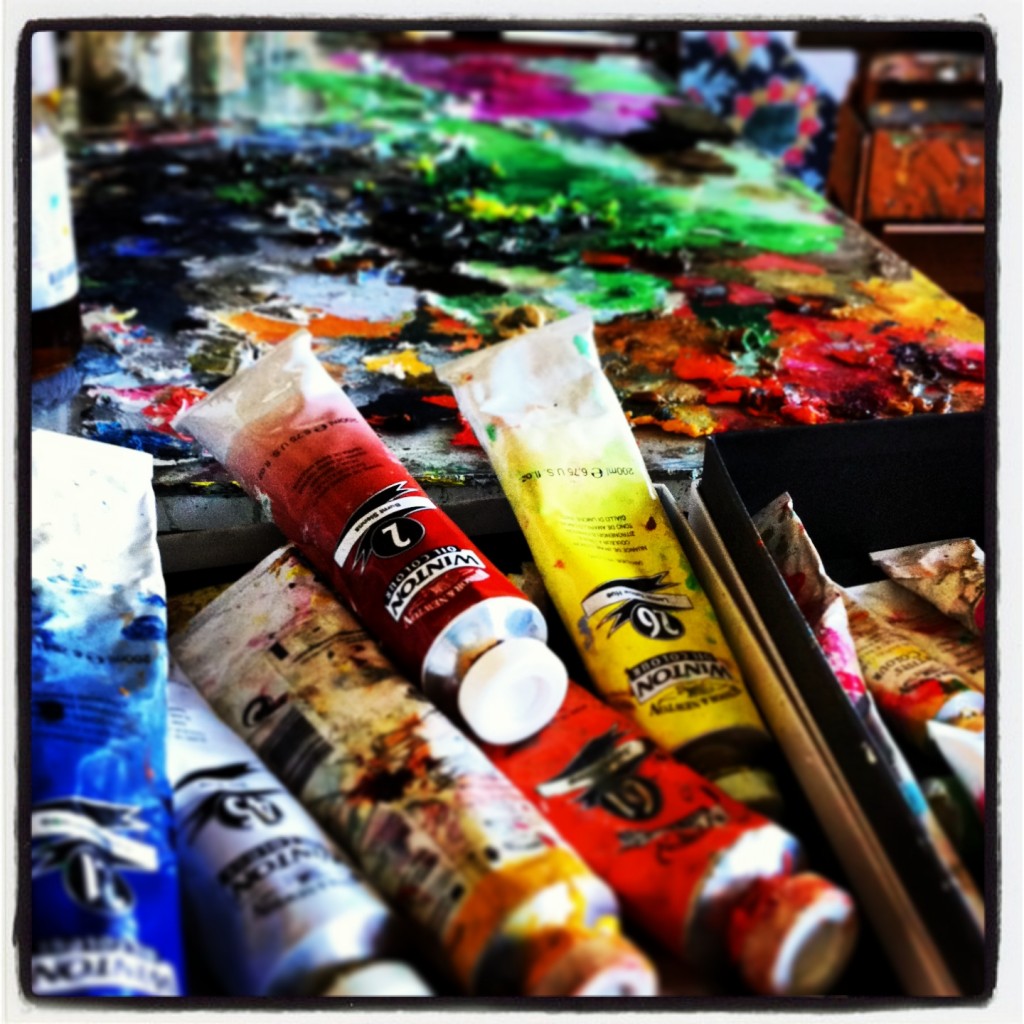
Big tubes of cheap paint. Time to get to work.
March 29th, 2013 by dave dorsey
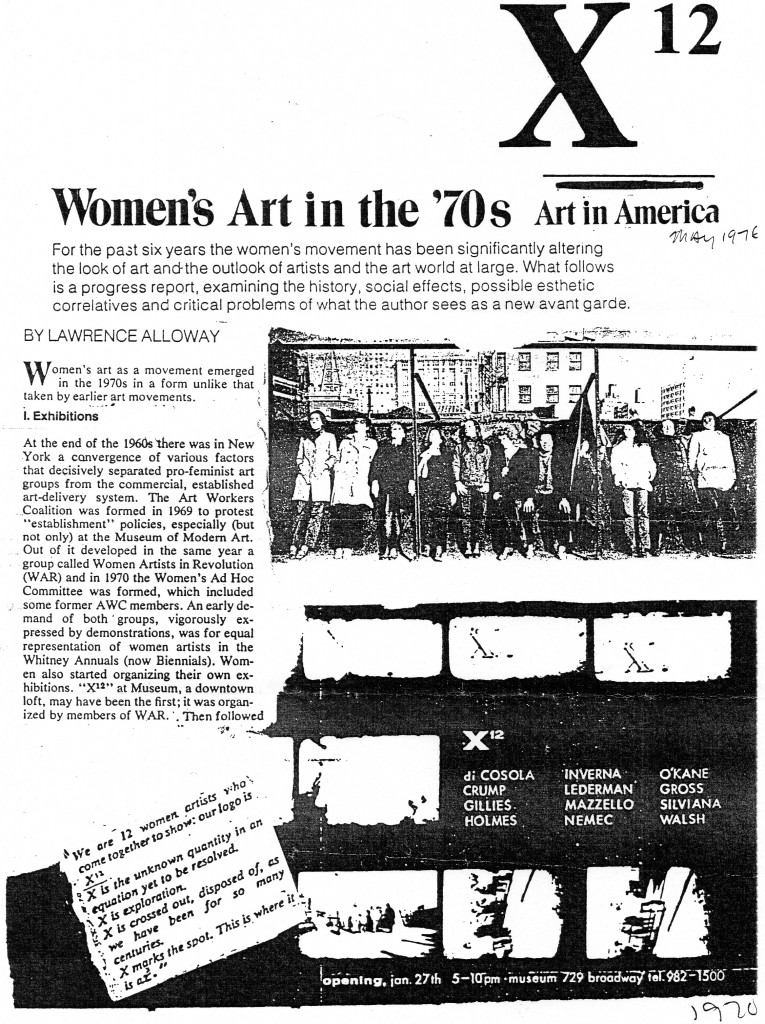
When I was in Manhattan a couple weeks ago, I spent a couple hours at Viridian asking Vernita Nemec about her experiences as an artist in the 70s. She talked about how it felt and still feels to be a woman in the art world, and also what life was like for an artist back then. In other words, how has the scene in lower Manhattan changed over the past 40 years. (Long story short, it was friendlier, more informal and ridiculously more affordable. To wit, the young Robert Mapplethorpe and Patti Smith.)
It’s pretty clear, from what she recalled, that walls have arisen between the successful and the struggling that simply didn’t exist back then. Art careers have become more professionalized, compared to a far more bohemian life in the early 70s. A New York artist’s life was less like something involving a career plan than an ongoing exclusive party, but with extremely lax security.
One thing wasn’t better back then: it was far more difficult to be a female artist. Vernita told me she and a friend conceived and organized what has never been recognized as the first all-woman art show in 1969. It was called X to the Twelfth Power: an exhibit of work by a dozen women, with X standing for their obscurity. None of them were known at the time—being a female artist meant, first and foremost, being unknown. By choice. most women artists, at that point, hesitated to identify themselves as women.
MORE
March 28th, 2013 by dave dorsey
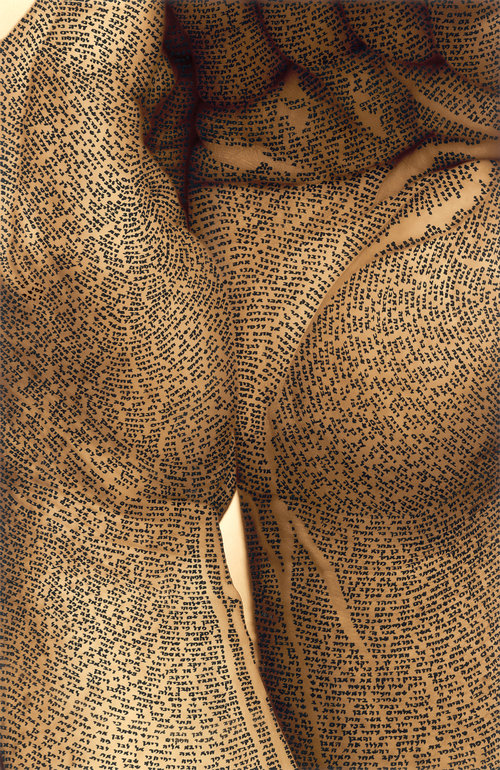
“Body Scripture II” is Ronit Bigal’s new exhibition featuring from the 27th of may 2010 at the Artists House in Tel Aviv. Photography, Calligraphy and floral ornamentation are the elements comprising this exhibition. Digital photography topped with drawings in black Indian ink produces an effect of bas-relief. Bigal photographs the body completely exposed. The camera explores the body, capturing different parts, discovering a world of hidden landscapes, textures, and unspoken eroticism. For the artist this was a journey of unforeseen surprise. Therefore she wraps parts of her photos with floral ornamentation and others with cited calligraphy taken from Biblical texts. They are almost abstract and enigmatic, arousing the viewer’s curiosity to discover what are the photographed objects, what meanings lies behind the texts; and whether there is a thematic affinity between them or, perhaps are the associations purely aesthetical? —Saatchi Online via Kottke,org
March 27th, 2013 by dave dorsey
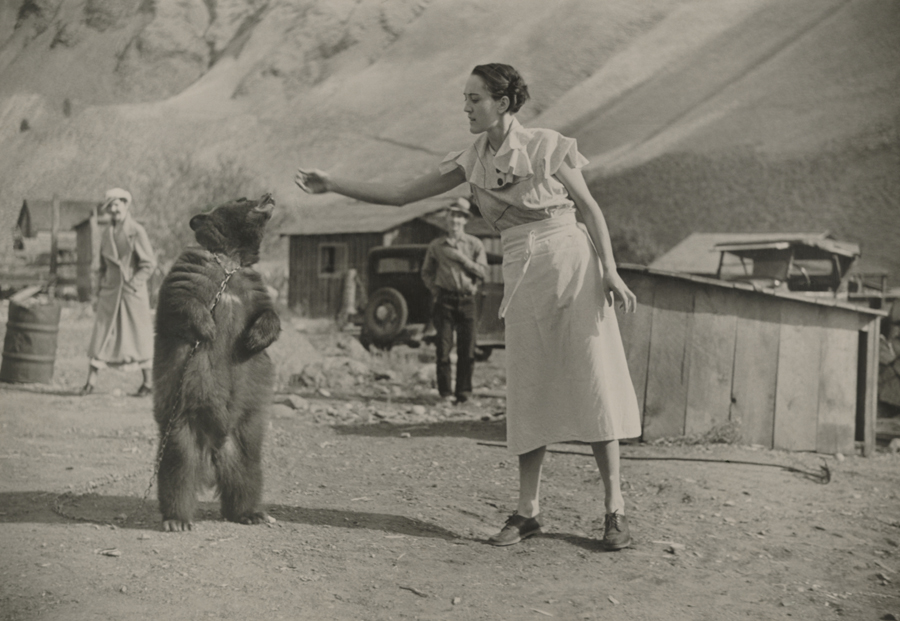
A woman feeds her pet bear in Riggins, Idaho. From National Geographic archives.
March 27th, 2013 by dave dorsey
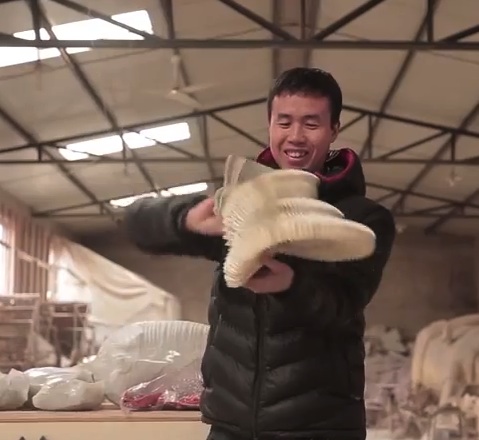
Li Hongbo with his collapsible paper sculpture
You have to see his work in motion to get the full effect, at YouTube. I like him as much as I like his work. Childlike intensity and delight.
March 25th, 2013 by dave dorsey
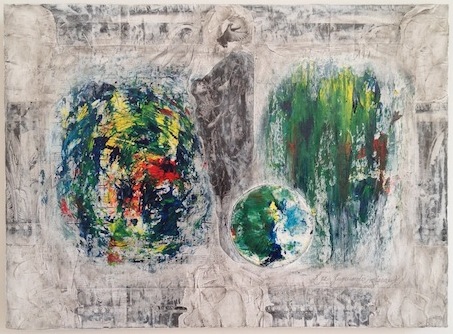
Paul D’Agostino, “Ahnung keiner Ahnung 9: Les fugues des oiseaux” (2012). Acrylic, charcoal, and painting ground with collaged elements on panel, 14 x 20 inches.
March 22nd, 2013 by dave dorsey
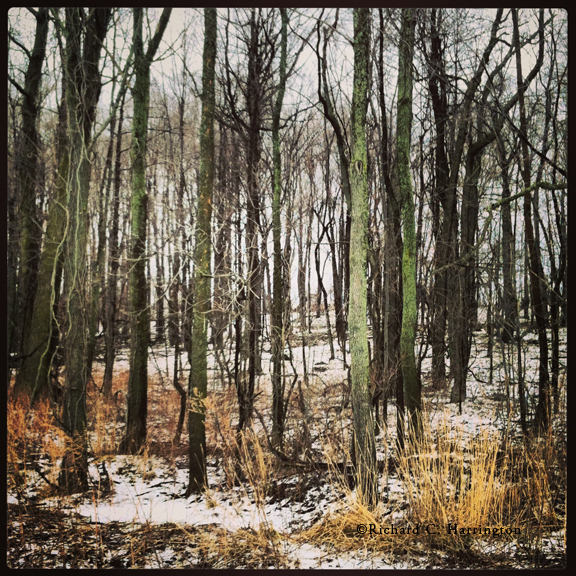
Beautiful little post from my friend Rick–including some of his great photographs, like the one above–about his encounters with coyotes not all that far south of our Rochester suburb. I remember telling him about the coyote pups we heard beside the house in Palm Springs we rented for a week last summer, and he dismissed it: “We hear them all the time here.” The way he conveys nature in this brief account reminds me of the way he does it in his paintings.
Just as I turned east over a culvert, I sensed something ahead of me. He must have done the same thing, because as my head came up, so did his, and we locked on each other about 15 feet apart. I’m sure if the visibility had been much more the 25 feet we had that afternoon he would never have let it happen. We stared for a moment, frozen. I heard the dogs’ collars tinkling behind me, turned to cut them off before a chase. But when I glanced back ahead, there was no need, the coyote had vanished. –Rick Harrington
March 20th, 2013 by dave dorsey
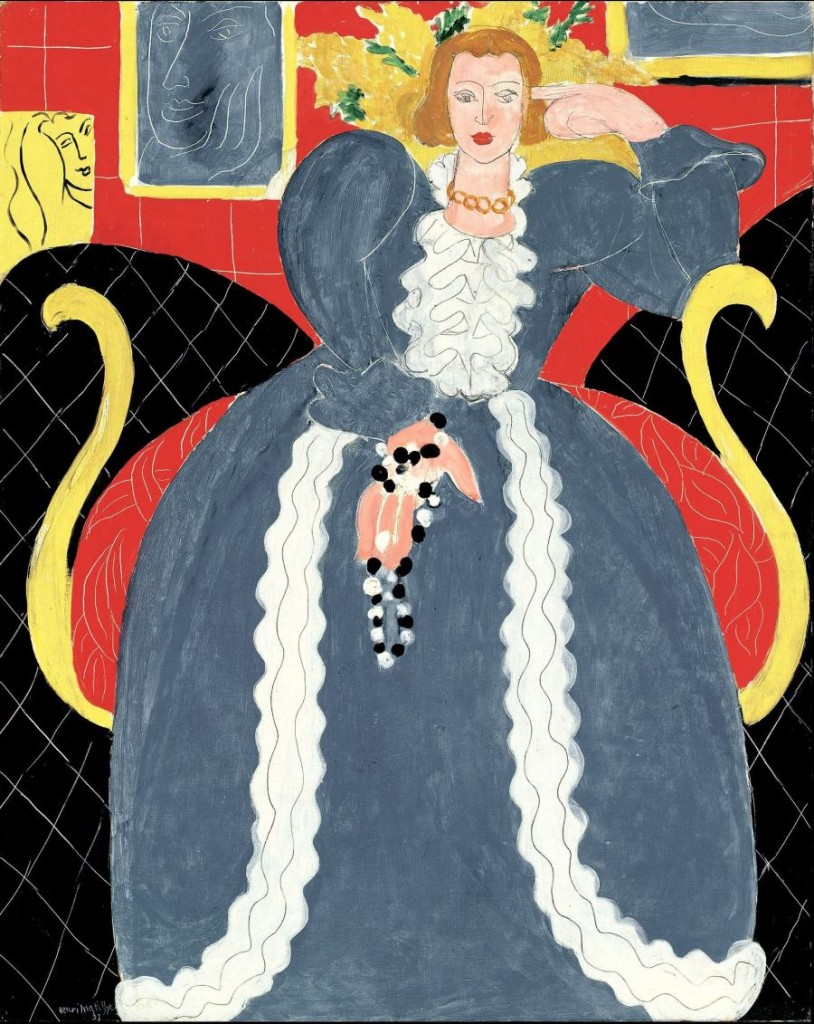
I got to the Metropolitan Museum of Art just in time to see Matisse: In Search of True Painting, the tremendous show which just ended, built around the French painter’s tendency to exhaustively try different variations on a theme. When he did this, and he did it a lot, I’ve never been sure whether he was trying to get something exactly right or simply exploring every possible way to render an image, the way many artists have repeatedly returned to the same image again and again: Monet’s haystacks and cathedrals, Warhol’s various riffs on a particular iconic image and Motherwell’s repeated reworkings of Ode to a Spanish Republic. In the case of Matisse, I’m never quite sure I like the later versions of particular paintings more than earlier ones. In some cases, I get less and less interested, the further he simplifies and refines a motif. But almost everything in this show seemed to be offering itself to me from a fresh, new angle. This was especially true of the first painting, Still Life With Compote and Fruit, one of the 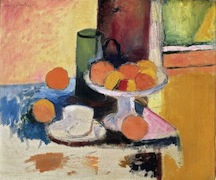 artist’s earliest paintings, whose incredibly subtle color—impossible to fully appreciate in the catalog—made me want to stay there at the entry into the show and skip whatever else was coming. It’s unfinished, and yet it’s as fine a painting as any he ever did, with incredibly delicate feeling in the balance between the two sections of muted green against the peach and salmon colors of the fruit. The tug-of-war between illusions of depth and the flat and uniform areas of color—an energizing opposition at the heart of what gives life to Matisse’s work—imbues the image with a dreamlike quality that seems to breathe as you keep your eye on its cluster of simple objects that reminded me of Morandi. And that was only the start. This show was a thrill, from start to finish, and taught me at least as much about the way Matisse painted as any other exhibition of his work I’ve seen, including MOMA’s Matisse: Radical Invention 1913-1917 which gave me an awed respect for the monumental paintings he did after his return from Morocco.
artist’s earliest paintings, whose incredibly subtle color—impossible to fully appreciate in the catalog—made me want to stay there at the entry into the show and skip whatever else was coming. It’s unfinished, and yet it’s as fine a painting as any he ever did, with incredibly delicate feeling in the balance between the two sections of muted green against the peach and salmon colors of the fruit. The tug-of-war between illusions of depth and the flat and uniform areas of color—an energizing opposition at the heart of what gives life to Matisse’s work—imbues the image with a dreamlike quality that seems to breathe as you keep your eye on its cluster of simple objects that reminded me of Morandi. And that was only the start. This show was a thrill, from start to finish, and taught me at least as much about the way Matisse painted as any other exhibition of his work I’ve seen, including MOMA’s Matisse: Radical Invention 1913-1917 which gave me an awed respect for the monumental paintings he did after his return from Morocco.
Yet I’m not sure I absorbed what this show was curated to emphasize. MORE
March 19th, 2013 by dave dorsey
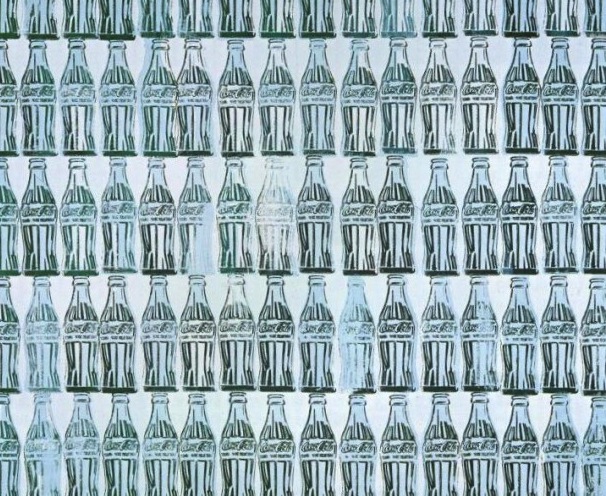 From The Nation, I loved the interpolation of the subscription pitch just where it counted, for maximum amusement:
From The Nation, I loved the interpolation of the subscription pitch just where it counted, for maximum amusement:
“The problem is, like many theories, this one has a hard time explaining how, in the midst of a revolution in the modes of cultural production, people are going to keep themselves in cat food, if you catch my drift . . . in a media environment that is still largely bound up with gatekeepers. Your WordPress blog is just never going to have the cachet of even a guest-blogging stint at The Atlantic. And one still, generally, needs the anointment of a record company in order to get the kind of press and, hell, capital investment, that it takes to make one’s first albums a success. And it sure helps to have three seasons of your TV show already produced and available for years on DVD to build the kind of audience who will gladly donate millions to keep you going.
Please support our journalism. Get a digital subscription for just $9.50!
Therein lies the rub: In this sort of hybrid environment, where we still have gatekeepers, creators still need to leverage themselves with existing brands in order to break into the conversation. And even businesspeople who dedicate themselves to the arts are obviously capitalists. Sure, on one side, certain aspects of the Internet—piracy, yes, but also sheer volume of stuff to look at and listen to—are putting pressure on profits. But on the other side, in an atmosphere of growing noise, artists still need these businesspeople to give them legitimacy in the early stages of their careers, to float them reputational capital. That is why you see places like The Atlantic, a profitable institution, kick up only a minor fuss when it fails to pay people. Journalists still need the legitimacy The Atlantic can confer to stand out. And that is no doubt how the people who own profitable arts-related businesses justify their free-labor practices to themselves.”
This was in response to a TED talk by Amanda Palmer, a video of which is accompanied by this commentary:
Don’t make people pay for music, says Amanda Palmer: Let them. In a passionate talk that begins in her days as a street performer (drop a dollar in the hat for the Eight-Foot Bride!), she examines the new relationship between artist and fan. Alt-rock icon Amanda Palmer believes we shouldn’t fight the fact that digital content is freely shareable — and suggests that artists can and should be directly supported by fans.
March 18th, 2013 by dave dorsey
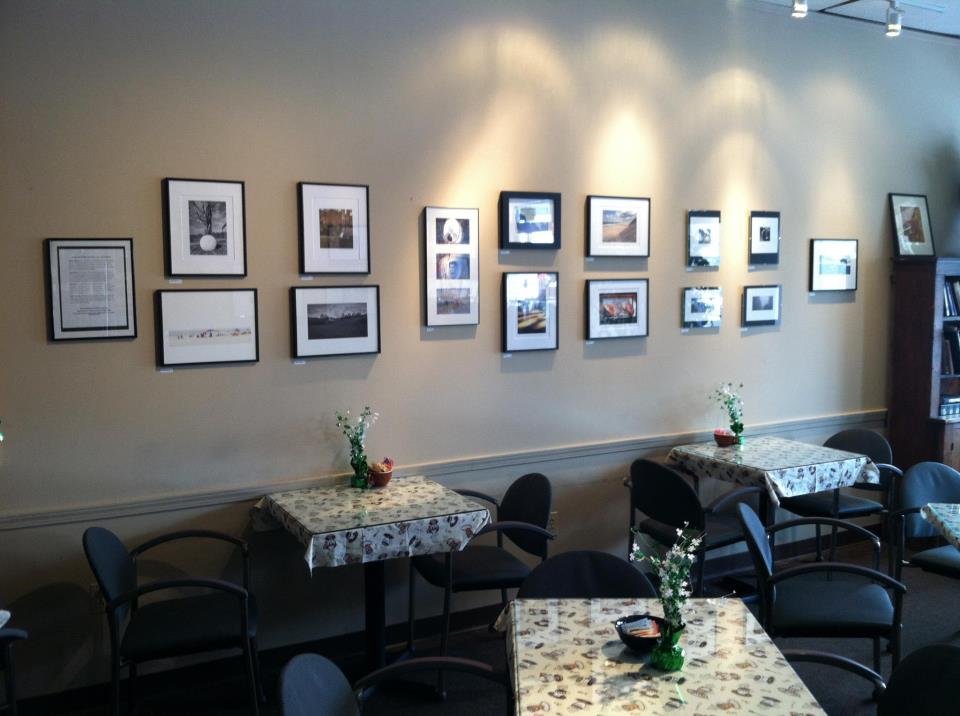
Four by Four at Canaltown Coffee Roasters
Four photographs each by four people–Bob Shea, Hank Shaw, Walt Thomas and somebody named Dave Dorsey–are on view at Canaltown Coffee Roasters across from the new Wegmans going up on East Ave. Some excellent photography with few pretensions. It’s nice to think someone might get some pleasure by looking up from a smart phone in order to take them in for a few minutes. Bob organized the show and did a lot of the framing. At home in Tennessee, Walt participated in the afternoon reception via Google hangout using Hank’s laptop to get a look at what was happening, though he wasn’t picking up much conversation over the background noise, via the laptop’s microphone. Hank had me laughing through most of the reception. The people who showed up to look at the work had some great questions and stuck around. Bob, Hank and Walt are all more serious about photography than I am, and they know a lot more about cameras and software. I depend on my Nikon mostly as a source of images for paintings. Walt has had one of his photographs included in a Manifest Gallery INPHA annual and is the administrator of a Posterous site for photography, though that’s coming down soon, thanks to the demise of Posterous. And, oh yeah, he also sold one of his shots. The work was all uniformly interesting and really well done and though it was a struggle pulling the whole thing together at one point or another, it was gratifying to see that people actually showed up to take a look. Facebook strikes again. Four by Four ought to become a regular thing.




















